Java-IO 流
Java-IO流
0x01 前言
IO是指 Input/Output,即输入和输出。以内存为中心:
为什么要把数据读到内存才能处理这些数据?因为代码是在内存中运行的,数据也必须读到内存,最终的表示方式无非是 byte数 组,字符串等,都必须存放在内存里。
从 Java 代码来看,输入实际上就是从外部,例如,硬盘上的某个文件,把内容读到内存,并且以 Java 提供的某种数据类型表示,例如,byte[],String,这样,后续代码才能处理这些数据。
因为内存有“易失性”的特点,所以必须把处理后的数据以某种方式输出,例如,写入到文件。Output 实际上就是把 Java 表示的数据格式,例如,byte[],String等输出到某个地方。
IO 流是一种顺序读写数据的模式,它的特点是单向流动。数据类似自来水一样在水管中流动,所以我们把它称为 IO 流。
在讲 IO 流之前,我们先讲一讲 Java 关于文件的一些操作。
0x02 创建文件的三种方式
因为与文件有关,我这里的路径也贴出来比较好
Reappearance\Serialable\src\IOStream
准备将文件都放到新建的 CreateForFile 文件夹中
建议路径跑通一个之后,其余复制粘贴路径。
1. 根据路径创建一个 File 对象
- 方法
new File(String pathname)
1
2
3
4
5
6
7
8
9
10
11
12
13
14
15
16
17
18
19
20
21
| package src.IOStream;
import java.io.File;
import java.io.IOException;
public class newFile {
public static void main(String[] args) {
createFile();
}
public static void createFile(){
File file = new File("Serialable/src/IOStream/CreateForFile/new1.txt");
try{
file.createNewFile();
System.out.println("Create Successfully");
} catch (IOException e){
e.printStackTrace();
}
}
}
|
2. 根据父目录 File 对象,在子路径创建一个文件
- 方法
new File(File parent, String child)
1
2
3
4
5
6
7
8
9
10
11
12
13
14
15
16
17
18
19
20
21
| package src.IOStream;
import java.io.File;
import java.io.IOException;
public class newFile02 {
public static void main(String[] args) {
createFile();
}
public static void createFile(){
File parentFile = new File("Serialable/src/IOStream/CreateForFile");
File file = new File(parentFile, "new2.txt");
try{
file.createNewFile();
System.out.println("Create Successfully");
} catch (IOException e){
e.printStackTrace();
}
}
}
|
其实和第一个方法大同小异。
3. 根据父目录路径,在子路径下生成文件
- 方法
new File(String parent, String child)
和之前两种方法还是有一些差距的。
1
2
3
4
5
6
7
8
9
10
11
12
13
14
15
16
17
18
19
20
21
22
| package src.IOStream;
import java.io.File;
import java.io.IOException;
public class newFile03 {
public static void main(String[] args) {
createFile();
}
public static void createFile(){
String parentPath = "Serialable/src/IOStream/CreateForFile";
String fileName = "new3.txt";
File file = new File(parentPath, fileName);
try{
file.createNewFile();
System.out.println("Create Successfully");
} catch (IOException e){
e.printStackTrace();
}
}
}
|
创建三个 txt 文件。
0x03 获取文件信息
我们先在 new1.txt 当中编辑一些消息
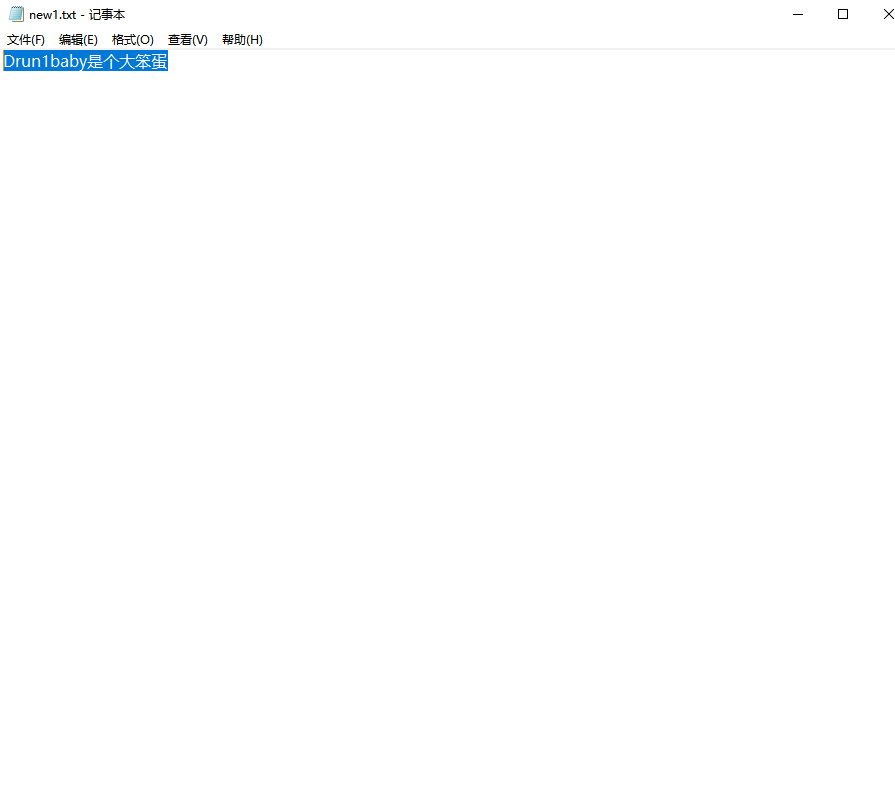
我们通过 file 类的方法名进行一些基本信息的获取
1
2
3
4
5
6
7
8
9
10
11
12
13
14
15
16
17
18
19
| package src.IOStream;
import java.io.File;
public class GetFileInfo {
public static void main(String[] args) {
getFileContents();
}
public static void getFileContents(){
File file = new File("Serialable/src/IOStream/CreateForFile/new1.txt");
System.out.println("文件名称为:" + file.getName());
System.out.println("文件的绝对路径为:" + file.getAbsolutePath());
System.out.println("文件的父级目录为:" + file.getParent());
System.out.println("文件的大小(字节)为:" + file.length());
System.out.println("这是不是一个文件:" + file.isFile());
System.out.println("这是不是一个目录:" + file.isDirectory());
}
}
|
输出如图

0x04 目录与文件操作
1. 文件删除
1
2
3
4
5
6
7
8
9
10
11
12
13
14
15
| package src.IOStream;
import java.io.File;
import java.lang.reflect.Field;
public class FileDelete {
public static void main(String[] args) {
deleteFile();
}
public static void deleteFile(){
File file = new File("Serialable/src/IOStream/CreateForFile/new1.txt");
System.out.println(file.delete() ? "Delete Successfully":"Delete failed");
}
}
|

2. 目录删除
- 方法
file.delete(目录),这里有个小坑,只有空的目录才可以删除,不然会显示删除失败。
- 我在
CreateForFile 同级目录下新建了一个文件夹 CreateForDelete 用以测试。
1
2
3
4
5
6
7
8
9
10
11
12
13
14
| package src.IOStream;
import java.io.File;
public class DirectoryDelete {
public static void main(String[] args) {
deleteDirectory();
}
public static void deleteDirectory(){
File file = new File("Serialable/src/IOStream/CreateForDelete");
System.out.println(file.delete()? "Delete Successfully":"Delete failed");
}
}
|
3. 创建单级目录
1
2
3
4
5
6
7
8
9
10
11
12
13
14
| package src.IOStream;
import java.io.File;
public class CreateSingleDirectory {
public static void main(String[] args) {
createSingleDir();
}
public static void createSingleDir(){
File file = new File("Serialable/src/IOStream/CreateForDirectory");
System.out.println(file.mkdir() ? "Create Successfully":"Create failed");
}
}
|
成功创建
4. 创建多级目录
- 方法
file.mkdirs(),注意多了个 s 别搞错了。
1
2
3
4
5
6
7
8
9
10
11
12
13
14
15
16
| package src.IOStream;
import java.io.File;
public class CreateMultiDirectory {
public static void main(String[] args) {
createMultiDir();
}
public static void createMultiDir(){
File file = new File("Serialable/src/IOStream/CreateMultiDirectory/test");
System.out.println(file.mkdirs() ? "Create Successfully":"Create failed");
}
}
|

0x05 回归 IO 知识点 —— IO 流分类
按照操作数据单位不同分为:字节流和字符流
- 字节流(8bit,适用于二进制文件)
- 字符流(按字符,因编码不同而异,适用于文本文件)
按照数据流流向不同分为:输入流和输出流
按照流的角色不同分为:节点流,处理流/包装流
| 抽象基类 |
字节流 |
字符流 |
| 输入流 |
InputStream |
Reader |
| 输出流 |
OutputStream |
Writer |
- 到这里就非常重要了,因为它与我们后续的命令执行直接相关。这些 IO 流在我们命令执行的 Payload 当中充当着缓冲的作用。
0x06 关于文件流的一些操作
要讲文件流的一些操作,不妨先以 Payload 看起,这样不会特别枯燥与抽象。
1. Runtime 命令执行操作的 Payload
1
2
3
4
5
6
7
8
9
10
11
12
13
14
15
16
17
18
| package src.CommandExec;
import java.io.ByteArrayOutputStream;
import java.io.InputStream;
public class RuntimeExec {
public static void main(String[] args) throws Exception {
InputStream inputStream = Runtime.getRuntime().exec("whoami").getInputStream();
byte[] cache = new byte[1024];
ByteArrayOutputStream byteArrayOutputStream = new ByteArrayOutputStream();
int readLen = 0;
while ((readLen = inputStream.read(cache))!=-1){
byteArrayOutputStream.write(cache, 0, readLen);
}
System.out.println(byteArrayOutputStream);
}
}
|
其中,byte[] cache = new byte[1024] 用来缓存数据,我们结合这一串 Payload 来学习 Java IO 流甚好。
read() 方法
read() 方法到底是啥样的呢,我们跳进去看看
1
2
3
4
5
6
7
8
9
10
11
12
| read()
public int read() throws IOException
从此输入流中读取一个数据字节。
如果没有输入可用,则此方法将阻塞。
指定者: 类 InputStream 中的 read
返回: 下一个数据字节;如果已到达文件末尾,则返回 -1。
抛出: IOException - 如果发生 I/O 错误。
|
之前我们用 file 的一系列操作读取过文件的信息,现在我们用 FileInputStream.read() 来读取文件内容。
1
2
3
4
5
6
7
8
9
10
11
12
13
14
15
16
17
18
19
20
21
22
23
24
25
26
27
28
29
30
| package src.IOStream;
import java.io.FileInputStream;
import java.io.IOException;
public class FileInputRead {
public static void main(String[] args) {
readFile();
}
public static void readFile(){
String filePath = "Serialable/src/IOStream/CreateForFile/new1.txt";
FileInputStream fileInputStream = null;
int readData = 0;
try{
fileInputStream = new FileInputStream(filePath);
while((readData = fileInputStream.read())!=-1){
System.out.print((char)readData);
}
} catch (IOException e){
e.printStackTrace();
} finally {
try{
fileInputStream.close();
} catch (IOException e){
e.printStackTrace();
}
}
}
}
|
成功读取到文件内容,这里有个小坑,若我们 sout 的时候进行了换行,则每一个字符都会经过换行。而如果不设置换行,才是正常的输出。
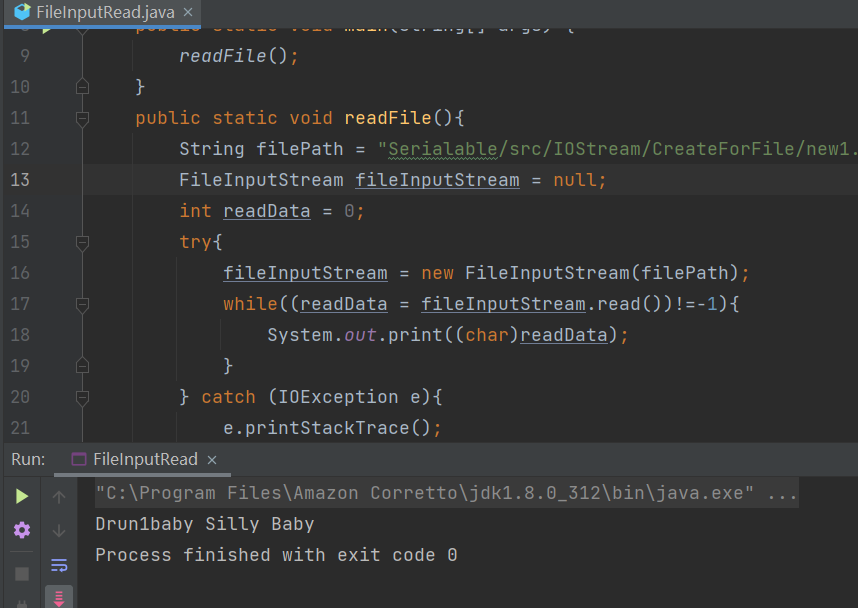
read(byte[] d) 方法
允许在方法中添加一个字节数组。
这种方式很有意思,当我们设置缓冲区的值为 8 时,若文件中的字符长度超过了 8,则会换行输出。这和上面的换行实际上是异曲同工。
再回到之前我们讲的 Runtime 类进行命令执行的 Payload,在那里,我们设置的 Cache 缓冲区的值为 1024.
read(byte[] d) 方法
1
2
3
4
5
6
7
8
9
10
11
12
13
14
15
16
17
18
19
20
21
22
23
24
25
26
27
28
29
30
31
| package src.IOStream;
import java.io.FileInputStream;
import java.io.IOException;
public class FileInputRead02 {
public static void main(String[] args) {
readFile();
}
public static void readFile(){
String filePath = "Serialable/src/IOStream/CreateForFile/new1.txt";
FileInputStream fileInputStream = null;
byte[] cache = new byte[8];
int readLen = 0;
try {
fileInputStream = new FileInputStream(filePath);
while((readLen = fileInputStream.read(cache)) != -1){
System.out.println(new String(cache, 0, readLen));
}
} catch (IOException e){
e.printStackTrace();
} finally {
try {
fileInputStream.close();
} catch (IOException e){
e.printStackTrace();
}
}
}
}
|
这里的 while 会运行三次,会读取文件当中所有的字符。
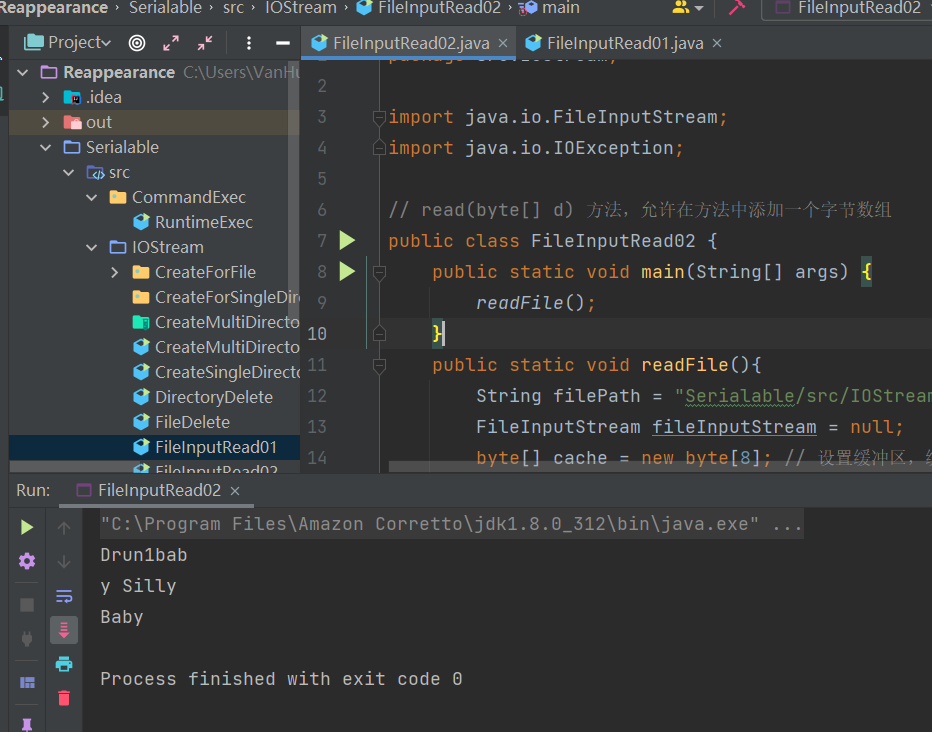
3. FileOutputStream
往文件里面写数据
简单的 write(int b) 这里先不提
write(byte[] b) 方法
1
2
3
4
5
6
7
8
9
10
| write(byte[] b)
public void write(byte[] b)
throws IOException
将 b.length 个字节从指定 byte 数组写入此文件输出流中。
覆盖:
类 OutputStream 中的 write
参数:
b - 数据。
抛出:
IOException - 如果发生 I/O 错误。
|
我们尝试向文件当中写入数据,这里写代码的时候小心一点,容易踩坑的。
1
2
3
4
5
6
7
8
9
10
11
12
13
14
15
16
17
18
19
20
21
22
23
24
25
26
27
28
29
30
31
32
33
34
35
36
37
38
| package src.IOStream;
import java.io.FileNotFoundException;
import java.io.FileOutputStream;
import java.io.IOException;
public class FileOutputWrite01 {
public static void main(String[] args) {
writeFile();
}
public static void writeFile() {
String filePath = "Serialable/src/IOStream/CreateForFile/new1.txt";
FileOutputStream fileOutputStream = null;
try {
fileOutputStream = new FileOutputStream(filePath);
String content = "gulugulu";
try {
fileOutputStream.write(content.getBytes());
} catch (IOException e) {
e.printStackTrace();
}
}catch (FileNotFoundException e){
e.printStackTrace();
}
finally {
try {
fileOutputStream.close();
} catch (IOException e){
e.printStackTrace();
}
}
}
}
|
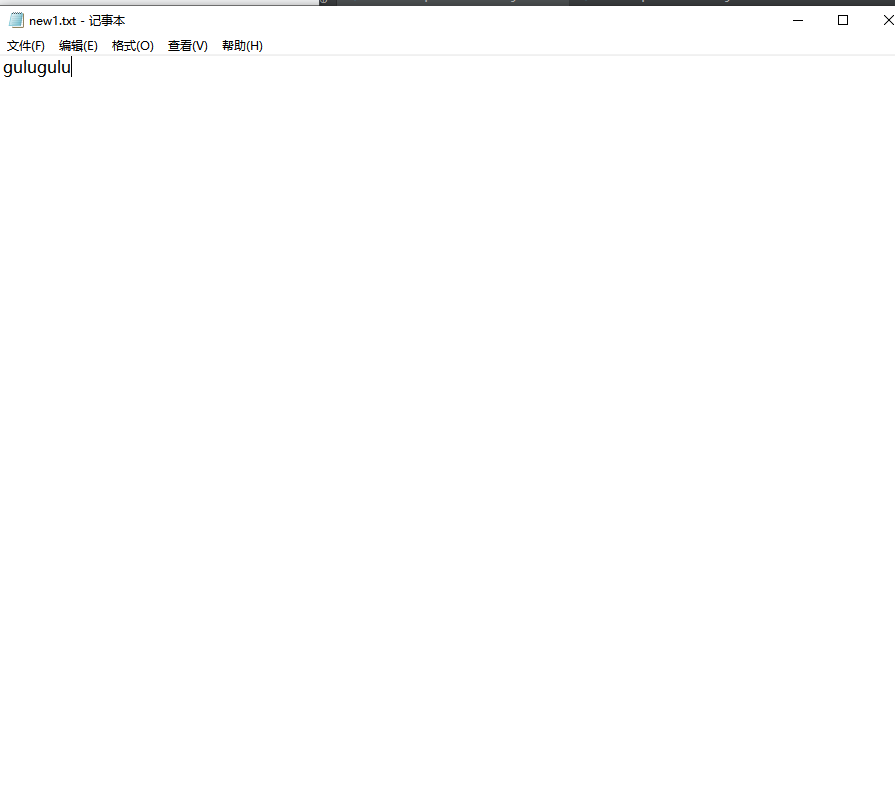
write(byte[] b, int off, int len) 方法
- 将指定 byte 数组中从偏移量 off 开始的 len 个字节写入此文件输出流。
这里的长度一定要与输入的字符相等。
1
2
3
4
5
6
7
8
9
10
11
12
13
14
15
16
17
18
19
20
21
22
23
24
25
26
27
28
29
30
31
32
33
34
35
36
37
38
39
| package src.IOStream;
import java.io.FileNotFoundException;
import java.io.FileOutputStream;
import java.io.IOException;
import java.nio.charset.StandardCharsets;
public class FileOutputWrite02 {
public static void main(String[] args) {
writeFile();
}
public static void writeFile() {
String filePath = "Serialable/src/IOStream/CreateForFile/new1.txt";
FileOutputStream fileOutputStream = null;
try {
fileOutputStream = new FileOutputStream(filePath);
String content = "drinkdrink";
try {
fileOutputStream.write(content.getBytes(StandardCharsets.UTF_8), 0, 10);
} catch (IOException e) {
e.printStackTrace();
}
}catch (FileNotFoundException e){
e.printStackTrace();
}
finally {
try {
fileOutputStream.close();
} catch (IOException e){
e.printStackTrace();
}
}
}
}
|

追加写入
如果想要写入的数据不被覆盖,可以设置 FileOutputStream 的构造方法 append 参数设置为 true
1
2
3
| fileOutputStream = new FileOutputStream(filePath);
fileOutputStream = new FileOutputStream(filePath), true;
|
利用前文讲的 fileInputStream 和 fileOutputStream 进行文件拷贝。
原理上来说,先将文件的内容(注意,其实图片当中也是内容,这个内容不光是文字!) 读取出来,再写入新的文件当中。
1
2
3
4
5
6
7
8
9
10
11
12
13
14
15
16
17
18
19
20
21
22
23
24
25
26
27
28
29
30
31
32
33
34
35
36
| package src.IOStream;
import java.io.FileInputStream;
import java.io.FileOutputStream;
import java.io.IOException;
public class FileCopy {
public static void main(String[] args) {
copyFile();
}
public static void copyFile(){
String srcFilename = "Serialable/src/IOStream/CreateForFile/new1.txt";
String desFilename = "Serialable/src/IOStream/CreateForFile/new2.txt";
FileInputStream fileInputStream = null;
FileOutputStream fileOutputStream = null;
try {
fileInputStream = new FileInputStream(srcFilename);
fileOutputStream = new FileOutputStream(desFilename);
byte[] cache = new byte[1024];
int readLen = 0;
while((readLen = fileInputStream.read(cache)) != -1){
fileOutputStream.write(cache, 0, readLen);
}
} catch (IOException e){
e.printStackTrace();
} finally {
try {
fileInputStream.close();
fileOutputStream.close();
} catch (IOException e){
e.printStackTrace();
}
}
}
}
|
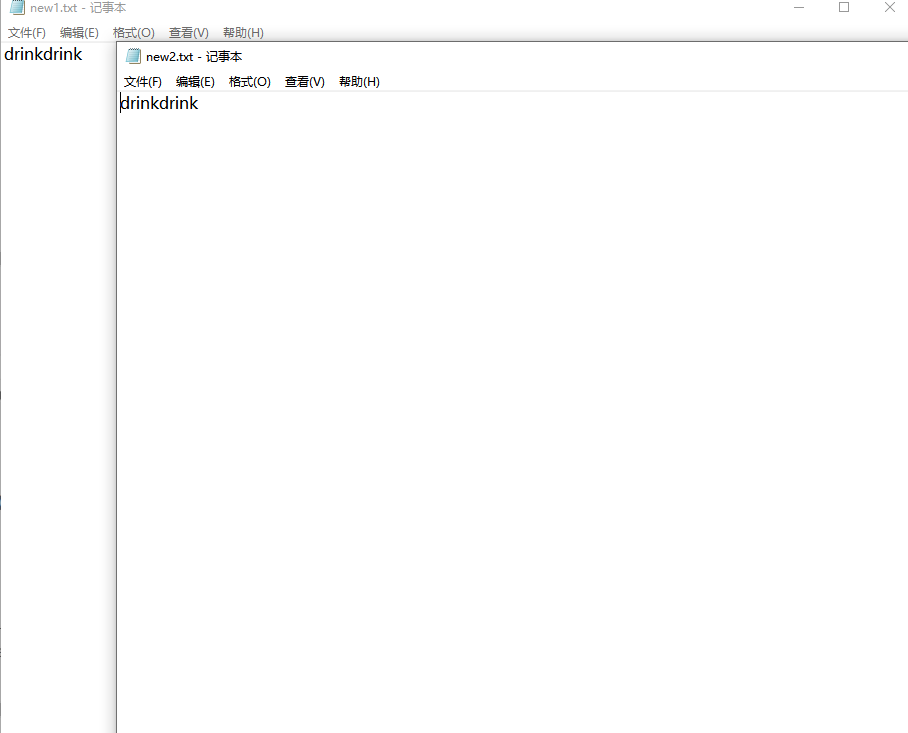
5. FileReader
1
2
3
| public class FileReader extends InputStreamReader
用来读取字符文件的便捷类。此类的构造方法假定默认字符编码和默认字节缓冲区大小都是适当的。要自己指定这些值,可以先在 FileInputStream 上构造一个 InputStreamReader。
FileReader 用于读取字符流。要读取原始字节流,请考虑使用 FileInputStream。
|
下方测试代码将会将 Serialable/src/IOStream/CreateForFile/new1.txt 中的 new1.tx 文件打印输出至控制台:
1
2
3
4
5
6
7
8
9
10
11
12
13
14
15
16
17
18
19
20
21
22
23
24
25
26
27
28
29
30
31
| package src.IOStream;
import java.io.FileReader;
import java.io.IOException;
public class FileReaderPrint {
public static void main(String[] args) {
readFile();
}
public static void readFile(){
String filePath = "Serialable/src/IOStream/CreateForFile/new1.txt";
FileReader fileReader = null;
try {
fileReader = new FileReader(filePath);
int readLen = 0;
char[] cache = new char[8];
while ((readLen = fileReader.read(cache))!=-1){
System.out.println(new String(cache, 0, readLen));
}
} catch (IOException e){
e.printStackTrace();
} finally {
try {
fileReader.close();
} catch (IOException e){
e.printStackTrace();
}
}
}
}
|
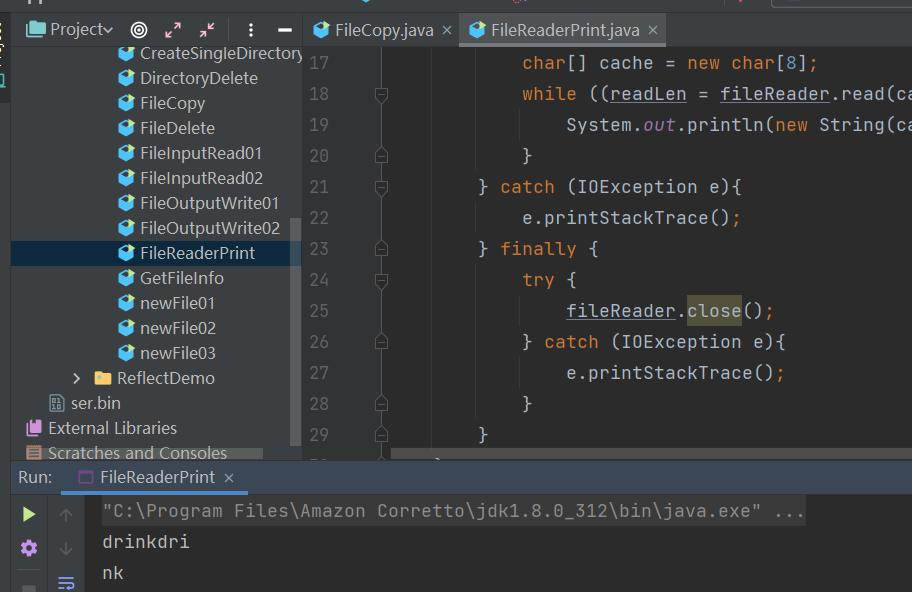
FileReader 将会一个一个字符读取,因此可以不乱码输出中文
0x07 小结
Java IO 流搞完咯,冲冲冲!










